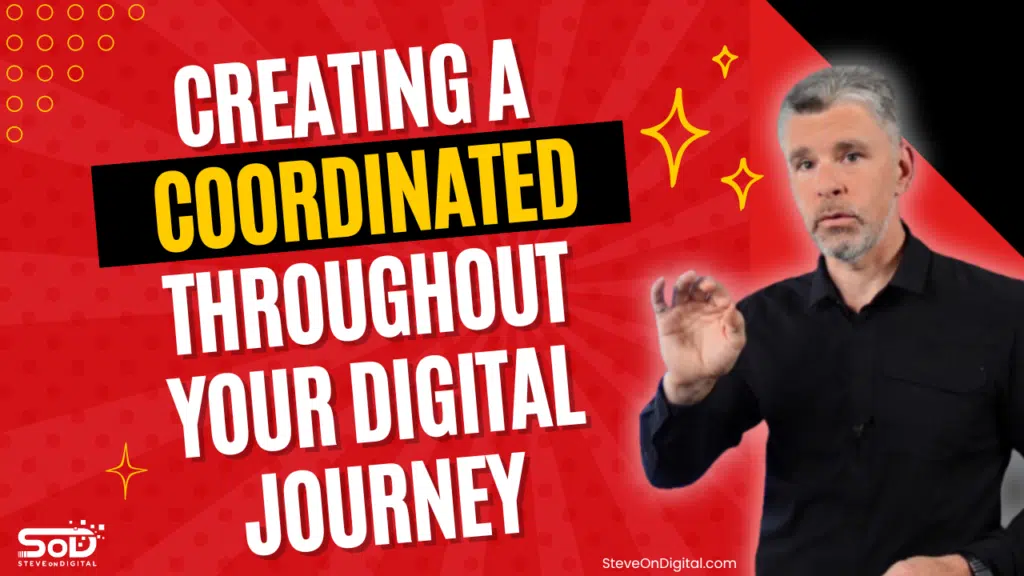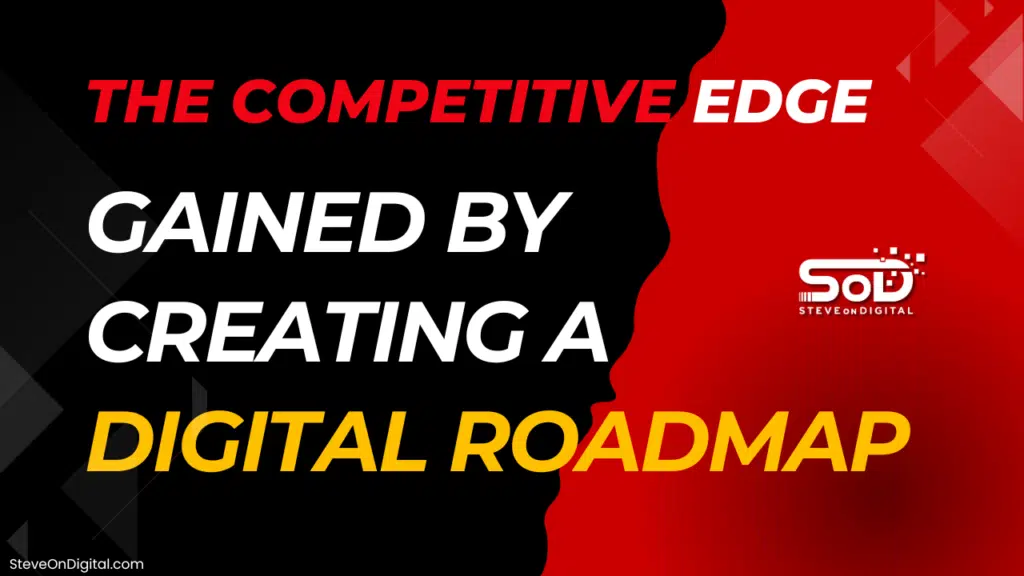Creating A Digital Roadmap: The Ultimate Guide

Creating a digital roadmap is crucial for business success and transformation. It acts like a GPS for your business, guiding you on where you are, where you need to go, and how to get there efficiently. To achieve this, it is essential to create a digital transformation roadmap, which involves assessing the organization’s digital maturity, defining objectives, prioritizing initiatives, integrating cutting-edge digital tools, and revolutionizing business practices. Without a digital roadmap, businesses often struggle with new digital technologies, leading to wasted resources and missed opportunities. I bring expertise in digital transformation, backed by an electrical engineering background, an MBA, and a master’s in Project Management. My goal is to help SMEs navigate the digital landscape with practical advice and insights. Understanding Digital Transformation Digital transformation refers to the integration of digital technologies into all areas of a business, fundamentally changing how you operate and deliver value to customers. It’s about more than just adopting new technologies; it’s about rethinking your business model and processes to stay competitive in today’s fast-paced digital world. A well-defined digital transformation roadmap is crucial in guiding the creation, execution, and importance of a strategic plan outlining the steps and milestones for integrating digital technologies into an organization’s operations. Digital transformation is not a one-size-fits-all solution. Each business needs to tailor its digital transformation strategy to meet its unique needs and goals. This involves understanding your current digital capabilities, identifying areas for improvement, and creating a plan to implement new digital technologies and processes. Why You Need A Digital Roadmap A digital roadmap is essential for guiding your business through the digital transformation process. It provides a clear, step-by-step plan for implementing digital technologies and processes, ensuring that all stakeholders are aligned and working towards the same goals. Digital initiatives play a crucial role in this process by implementing new digital strategies, technologies, and roadmaps to achieve more efficient business processes, digitally innovate, and create competitive advantages. Here are some key benefits of having a digital roadmap: Importance Of Effective Communication A focused digital strategy helps in aligning stakeholders and communicating the vision effectively. By clearly outlining the steps and goals of the digital transformation process, you can ensure that everyone in your organization understands the plan and their role in it. This is crucial for getting buy-in from all levels of the organization and ensuring that the transformation is successful. Viewing Digital Transformation As A Digital Transformation Journey Digital transformation is an ongoing process rather than a one-time project. It’s important to view it as a journey that involves continuous learning, adaptation, and improvement. A digital roadmap helps you stay focused on your long-term goals and make incremental progress towards achieving them. It allows you to break down the transformation process into manageable phases and track your progress along the way. Digital transformation roadmaps serve as the pathway from strategic vision to digital transformation goals, providing a clear, focused, and measurable plan for enacting transformation strategies. Supporting Decision-Making Knowing the reasons behind your digital transformation aids in making informed decisions during the process. A digital roadmap provides a framework for evaluating new technologies and processes, prioritizing projects, and allocating resources. It helps you make strategic decisions that align with your overall business goals and ensure that your digital transformation efforts are focused and effective. Assessing Your Starting Point Before you can create a digital roadmap, you need to assess your starting point. This involves evaluating your current digital capabilities, identifying areas for improvement, and setting realistic goals for your digital transformation journey. It is also crucial to review existing digital processes to identify any gaps or inefficiencies. Here are some steps to help you get started: Conducting A SWOT Analysis A SWOT analysis is a useful tool to find out your business’s good points and bad points, and to see what chances and risks are outside your business. By conducting a thorough SWOT analysis, you can gain a better understanding of your current digital capabilities and identify areas where you need to improve. Here are some tips for conducting a SWOT analysis: Category Description Strengths Strong leadership, skilled employees, advanced digital tools Weaknesses Outdated technologies, lack of digital skills, resistance to change Opportunities New technologies, market trends, customer demands Threats Competition, regulatory changes, economic instability Evaluating Current Digital Capabilities Assessing your existing digital tools and technologies is crucial for understanding your starting point in leveraging digital technology. This involves conducting a thorough review of your current digital processes, systems, and tools. Here are some tips for evaluating your current digital capabilities: By conducting a thorough assessment of your current digital capabilities, you can gain a better understanding of your starting point and identify areas for improvement. This will help you create a digital roadmap that is tailored to your unique needs and goals, and ensure the success of your digital transformation efforts. Identifying Your Highest Value Interaction The first step in creating a digital roadmap is identifying your highest value interaction. This is the process or interaction in your business that generates the most revenue. Focusing on this ensures that your digital transformation efforts have the maximum impact. Implementing an innovative digital strategy can further optimize these high-value interactions by leveraging new digital initiatives and technologies. Understanding Quote-To-Cash Processes The quote-to-cash process is the sequence of steps from providing a quote to receiving payment. This process is crucial because it directly affects your cash flow. Identifying and optimizing this process can significantly boost your business’s profitability. Here’s how you can approach it: Engaging With Your Team Involving your employees in the digital transformation process is essential. They can provide valuable insights and help ensure the success of your initiatives. It is crucial to drive change implementation and digital adoption across the entire organization, focusing on people-centric and cultural changes. Conducting Interviews And Workshops One effective way to engage with your team is by conducting interviews and workshops. These sessions allow you to gather insights about current processes and identify areas for improvement. Here
Creating A Coordinated Strategy Throughout Your Digital Journey

Creating a coordinated strategy helps businesses streamline operations, align goals, and save time and resources, ultimately driving success. I, Steve Johnston, am a Digital Transformation Specialist with expertise in helping small and medium-sized businesses navigate the digital landscape. My background in electrical engineering, an MBA, and a master’s in Project Management allow me to offer practical advice and insights to SMEs. Understanding Coordinated Strategy To create a coordinated strategy, you need to understand what it entails and why it is vital for your business. Definition And Importance A coordinated strategy aligns various business functions to work towards common goals and objectives. It involves strategic planning, project management, and continuous monitoring. This strategy ensures that all departments are on the same page, reducing conflicts and improving efficiency. For example, in my experience, when all teams understand the common goal, it reduces duplicated efforts and wasted time. Key Benefits A well-executed coordinated strategy brings numerous benefits: Steps To Create A Coordinated Strategy Here are the detailed steps I follow to create a coordinated strategy. Identifying Business Goals And Objectives Start by clearly defining your business goals and objectives. This step is critical as it lays the foundation for your strategy. Make sure these goals are specific, measurable, achievable, relevant, and time-bound (SMART). Conducting A Strategic Planning Process The strategic planning process involves evaluating your current position, identifying opportunities, and setting a clear path forward. Here’s how I usually approach this: Step Description Assess Current Situation Analyze strengths, weaknesses, opportunities, and threats (SWOT analysis) Set Strategic Objectives Define objectives based on SWOT analysis Develop Action Plans Outline detailed action plans to achieve objectives Involving Key Stakeholders Involving key stakeholders in the planning process is essential. This includes team members from various departments, as their input can provide valuable insights. In my practice, I always ensure that all relevant parties are engaged in the planning process to avoid silos and foster collaboration. Essential Components Of A Coordinated Strategy A coordinated strategy comprises several critical components. Clear Communication Channels Effective communication is the backbone of a coordinated strategy. Establishing clear communication channels ensures that everyone is informed and aligned with the strategic goals. Regular meetings and updates are essential to keep the team on track. Resource Allocation Efficient resource allocation is crucial for achieving your strategic goals. This involves distributing sufficient resources, such as time, money, and personnel, to where they are most needed. I always emphasize the importance of proper resource allocation to avoid bottlenecks and delays. Horizontal Coordination Horizontal coordination refers to the collaboration across different departments. It’s essential to break down departmental barriers and promote teamwork. For instance, I’ve seen how effective horizontal coordination can lead to innovative solutions and timely completion of projects. Role Of Project Management In Strategy Project management plays a crucial role in integrating and supporting a coordinated strategy. It ensures that all strategic initiatives are executed efficiently and effectively, leading to project success and the achievement of business goals. I’ve witnessed how robust project management practices can transform ideas into actionable plans, driving progress and innovation. Project Manager’s Role A project manager is at the heart of strategy execution. Their responsibilities include: A good project manager is like the captain of a ship, steering the team through the strategic planning process to reach the desired outcomes. Tracking Project Progress Monitoring and tracking project progress is essential for strategy execution. Here are some methods I find effective: By keeping a close eye on project progress, you can make informed decisions and adjustments to stay on course. Utilizing Data Analysis Tools Data analysis tools are indispensable for creating and executing a coordinated strategy. They provide valuable insights that inform decision-making and strategy refinement. Types Of Data Analysis Tools There are various data analysis tools available, each serving different purposes: Tool Type Examples Purpose Business Intelligence Tableau, Power BI Visualize data and identify trends Statistical Analysis SPSS, SAS Conduct in-depth statistical analysis Predictive Analytics RapidMiner, KNIME Forecast future trends and outcomes Each tool has its strengths and can be used to gain different types of insights. Benefits Of Data Analysis Data analysis offers several benefits: I’ve seen how leveraging data analysis tools can turn raw data into actionable insights, driving better strategy execution and project success. Setting Key Performance Indicators (KPIs) Establishing KPIs is essential to measure the success of your coordinated strategy. They serve as benchmarks to track progress and evaluate performance. Identifying Relevant KPIs When selecting KPIs, consider the following criteria: KPI Description Example Target Customer Satisfaction Score Measures customer satisfaction with products/services Achieve an average score of 8/10 Sales Growth Rate Measures the rate of increase in sales over time 10% growth per quarter Employee Productivity Measures the output of employees Complete 5 projects per month For example, if improving customer satisfaction is a goal, a relevant KPI might be the Net Promoter Score (NPS). Monitoring And Adjusting Kpis Monitoring KPIs is a continuous process. Here’s how I do it: By actively monitoring and adjusting KPIs, you can keep your strategy on track and achieve your business objectives. Mitigation Strategies For Potential Issues Creating a coordinated strategy isn’t without its challenges. It’s important to anticipate potential issues and have mitigation strategies in place to address them effectively. I’ve encountered various obstacles in my career, and having a plan to tackle them is crucial for project success. Common Challenges Here are some typical issues that might arise during strategy implementation: Solutions And Best Practices To overcome these challenges, I’ve found the following solutions and best practices to be effective: Common Challenges Solutions and Best Practices Communication Breakdowns Establish clear communication channels and encourage open dialogue Resource Constraints Prioritize resource allocation to critical tasks and ensure sufficient resources Resistance to Change Implement change management strategies, including training and support Lack of Clear Goals Define clear, measurable goals and objectives Importance Of Regular Meetings Regular meetings play a vital role in ensuring strategy alignment and progress. They provide an opportunity for team members to discuss updates, address potential
Top Benefits Of Creating A Digital Roadmap For Your Business

Creating a digital roadmap offers significant benefits for businesses today. It provides a strategic plan for implementing digital tools and technologies, ensuring alignment with business goals. A well-structured digital roadmap improves operational efficiency, enhances communication, and boosts technology adoption rates, making your business more competitive and efficient. As a Digital Transformation Specialist, I bring extensive expertise tailored for small and medium-sized businesses (SMEs). With a background in electrical engineering, an MBA, and a master’s in Project Management, I aim to help 1,000,000 business owners navigate the digital landscape. My experiences and practical insights from real-life scenarios are geared toward SMEs, reflecting my commitment to continuous learning and entrepreneurial support. Understanding The Benefits Of Creating A Digital Roadmap A comprehensive technology roadmap is a comprehensive plan that outlines how a business will implement digital tools and technologies. It’s crucial in the digital transformation process, guiding companies through various phases of adoption and integration. Definition Of A Digital Roadmap A digital transformation roadmap is a strategic plan that details how digital tools and technologies will be integrated into a business. This roadmap is vital for digital transformation, ensuring a structured approach to adopting new technologies. Components Of A Digital Roadmap The key components of a digital roadmap include ecosystem mapping and a detailed timeline. These elements help businesses visualize how various software and technologies interact and when they will be implemented. Component Description Software Ecosystem Shows how different software programs and tools work together. Implementation Timeline Details when each technological solution will be introduced and in what order. Key Benefits Of Creating A Digital Roadmap A well-structured digital roadmap offers numerous benefits, helping businesses streamline operations, improve communication, and increase technology adoption rates. Digital strategies empower companies to protect themselves from culture shifts and digital threats. Benefit Description Improved Operational Efficiency Streamlines processes, reduces redundancies, and leads to time and cost savings. Enhanced Communication Facilitates better team communication and collaboration. Higher Technology Adoption Rates Engages employees in the planning stages, leading to a smoother transition to new technologies. Improved Operational Efficiency A focused digital strategy helps companies identify digitalization opportunities and guides them on how to apply these to their current business models and offerings. Digital roadmaps streamline business processes, making operations more efficient and reducing redundancies. This leads to significant time and cost savings. Enhanced Communication A digital roadmap facilitates better communication within teams. It provides a clear visual representation of how and when new tools will be introduced, ensuring everyone is on the same page. Higher Technology Adoption Rates Involving team members in the planning process increases the adoption rates of new technologies. When employees understand and contribute to the roadmap, they are more likely to embrace new tools. Creating a digital roadmap isn’t just a plan; it’s a strategic move towards achieving digital success. From improving operational efficiency to enhancing communication and boosting technology adoption rates, the benefits are substantial. As someone who has seen the transformative power of a well-executed digital roadmap, I can attest to its value in driving business growth and staying competitive in today’s digital landscape. An innovative digital strategy can further enhance these efforts by implementing new digital initiatives and technologies to unlock new opportunities and create competitive advantages. The Role Of Digital Roadmaps In Digital Transformation Aligning With Business Strategy A digital roadmap aligns digital initiatives with overall business strategies. It’s not just about adopting new technologies; it’s about integrating them in a way that supports your business goals. I’ve seen firsthand how a well-aligned digital roadmap can transform a business, making it more competitive and efficient. Supporting Digital Transformation Journeys Digital roadmaps support continuous digital transformation. They provide a structured approach that allows businesses to evolve with technology. This continuous improvement is key to staying competitive in today’s market. Steps To Create An Effective Digital Roadmap Step Description Assessing Current Digital Capabilities Evaluate existing digital tools and technologies to understand current capabilities. Identifying Business Objectives Define clear business objectives that align with overall business goals. Developing the Roadmap Map out strategies and create an implementation plan. Implementing the Roadmap Execute the plan, monitor progress, and make necessary adjustments. Assessing Current Digital Capabilities The first step in creating a digital roadmap is to assess your current digital capabilities. This involves evaluating existing digital tools and technologies to understand where you stand and what you need. Identifying Business Objectives Next, define clear business objectives that the digital roadmap will support. These objectives should be aligned with your overall business goals to ensure that the digital strategy drives business success. Developing The Roadmap Once you have a clear understanding of your current capabilities and objectives, it’s time to develop a successful digital transformation roadmap. This involves mapping out strategies and creating an implementation plan. Implementing The Roadmap The final step is to implement the digital roadmap. This involves executing the plan, monitoring progress, and making necessary adjustments. Tools And Technologies For Digital Roadmaps Tool/Technology Description Digital Adoption Platforms Facilitates digital adoption and ensures employees are adequately trained. Project Management Tools Tools like Trello or Asana that help manage projects efficiently. Collaboration Software Tools like Slack or Microsoft Teams that enhance team collaboration. Emerging Technologies AI, Machine Learning, IoT, and Blockchain offer new opportunities for innovation and efficiency. Digital Adoption Platforms Digital adoption platforms are crucial for facilitating digital transformation. They help businesses integrate new technologies smoothly and ensure that employees are adequately trained. Software And Applications There are several essential software applications that can support the creation and maintenance of a digital roadmap. These tools help in project management and team collaboration. A well-defined technology strategy framework can provide a clear roadmap for technology initiatives, guiding investment decisions, and helping organizations deploy technology with a plan for the future. Emerging Technologies Emerging technologies like AI, machine learning, IoT, and blockchain are transforming digital roadmaps. These technologies offer new opportunities for innovation and efficiency. Challenges In Creating A Digital Roadmap Challenge Description Resistance to Change Employees may feel threatened by new technologies or processes.

